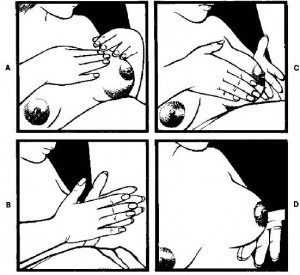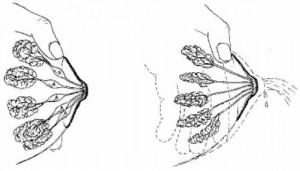a. Preparation of the Nipples.
Preparation of the nipples should begin during pregnancy.
(1) Roll nipples. The mother should roll her nipples with her thumb and forefinger two to three times each day (see figure 9-3).

(2) Massage breast (see figure 9-4).
(a) Place hand over the other above the breast.
(b) Gently, but firmly, exert pressure evenly with the thumbs across the top and fingers underneath the breast.
(c) Come together with the heel of the hand on each side and release at the areola, being careful not to touch the areola and nipple.
(d) Gently lift the breast from beneath and drop lightly.
NOTE: The above procedure should be repeated 4 to 5 times with each breast.

(3) Roughen nipples with a towel.
b. Initiation of Breast-feeding.
(1) Initial feeding is usually with one ounce of sterile water to determine if the newborn can swallow. The mother should begin feeding with five minutes of actual sucking time on each breast and increase feeding time after the baby has fed three consecutive times without difficulty. Each feeding should be initiated by alternating the breasts. The baby may receive glucose water after feeding until the milk comes in the breast.
(2) The advantages of breast-feeding are as follows:
(a) Colostrum contains less fat and sugar and more protein and salts than breast milk. It also contains large amounts of antibodies and vitamins and acts as a laxative to help expel meconium.
NOTE: Colostrum is the thin yellowish fluid secreted for the first several days after birth. Colostrum comes before the milk in the mother’s breast.
(b) Protein is more digestible than cow’s milk.
(c) The fat that is present is rich in essential fatty acids needed for brain growth.
(d) Colostrum contains lactose, which favors the development of bacteria in the intestines that serves as a protective function during infancy.
(e) The calcium-to-phosphorous ratio is ideal for the absorption of calcium needed for bone growth.
(f) It appears less likely to produce an obese child, promotes better tooth and jaw alignment, and protects against allergy development during infancy.
(g) Breast-feeding is convenient and eliminates formula preparation.
(h) Breast-feeding is economical.
c. Contraindications.
(1) Nipple or breast lesions may appear (depending on the type).
(2) If the mother becomes pregnant, the milk will usually start to dry up.
(3) Maternal illness.
(4) Need of mother to return to work (although excellent battery operated breast pumps are now available and very inexpensive).
(5) Inability of the mother to psychologically adjust.
(6) A woman with cardiac or established renal disease may be discouraged from nursing.
(7) Infections.
d. Common Breast-Feeding Problems.
(1) Delayed milk production (see figure 9-5). This is usually the earliest of breast-feeding problems. It occurs if the baby is not breast-fed within a short time after birth or not fed frequently enough.

(2) Sore breasts.
(a) The mother should let the baby breast-feed initially for ten to thirty minutes every two to three hours and gradually increase the amount of time. If her breasts are not empty after feeding, have the mother to express the milk into a bottle and refrigerate for later feedings.
(b) Improper position may cause soreness. Advise the mother that the infant should have a portion of the areola, in addition to the nipple in his mouth (see figure 9-6). Just chewing or sucking on the nipple may cause breast soreness.

(3) Engorgement. This normally occurs on or about the third postpartum day. It results from an increase of milk into the milk ducts combined with increased blood and lymph supply to the breast. The breast becomes hard and painful. It is usually more common in the first-time breast-feeding mother. Engorgement can be prevented by:
(a) Manual expression of milk (figure 9-7) if the breasts are full but the infant is not ready to nurse, or if the infant can’t get hold of the nipple because the skin is too tight.

(b) Wearing a supportive bra.
(c) Frequent nursing, if not too painful.
(d) Warm compresses applied to the sore breasts.
NOTE: The thumb and forefinger are placed on opposite sides of the breast just behind the areola. The lactiferous sinuses (ampulla A) are compressed, and milk is forced out.
(4) Leaking breasts.
(a) This is a common annoyance. A conditioned response will occur in the mother when she sees or hears a baby that causes the milk to let down.
(b) The mother should fold her arms across her breasts and press them firmly against her chest wall. This will stop the leaking. Advise her to place absorbent pads in her bras.
(5) Maternal anxiety. This will decrease milk production.
(a) An infant reacting to maternal anxiety will usually act in one of two ways.
1 He will suck, stop, cry, suck, stop, cry, and then may regurgitate.
2 He will suck, stop, cry, refuse to nurse, and continue to cry.
(b) Teach the mother relaxation techniques. Tell her to feed her baby in a quiet area.
(6) Sore, cracked, or fissured nipples.
(a) Causes.
1 Infant not having the nipple and areola properly in the mouth.
2 “Friction” of the baby’s gums on the nipple.
3 Infant being allowed to suck on an empty breast.
4 Washing the nipples with soap, which is drying.
5 Failure to break suction before removing the infant from the breast.
(b) Nursing interventions. Teach the mother proper nursing techniques and proper breast care.
(7) Breast infection.
(a) Most often caused by the causative organism, Staphylococcus areus.
(b) Entry is gained through a cracked or fissured nipple.
(c) The infection is usually interstitial and not intraductal, so the infection will not harm the baby.
(d) Nursing interventions. Instruct the mother on proper breast care. If breast soreness is present, have the mother to express milk into a bottle to feed to her baby.
